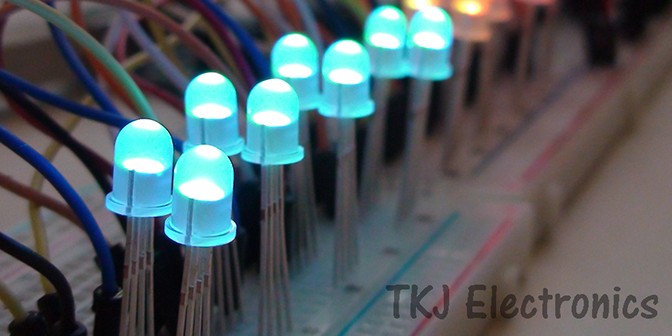(Photo above: RGB-LED Project at Arduino)
The creative vitality of Oregon has been measured by the Creative Vitality Index, commissioned by the Oregon Arts Commission, asking what role does creativity play in local communities.
The index measures the health of the local and state creative economy as it compares to the national index and creates a benchmark for future measurement. Since it was developed by the Arts Commission you might surmise that it measures how art impacts our local communities but the creative economy reach goes much farther than that.
The index is a reflection of the vigor of the creative sector of the economy that includes a vast range of jobs from architects, visual artists, graphic, fashion, interior and product designers to musicians and singers, filmmakers, writers and publishers (both online and in print). It also counts the many individuals who participate in these creative enterprises by purchasing and enjoying the fruits of their labors. In four years of measuring Oregon’s creative vitality, the state has performed above the national norm.
The new creative goes beyond the traditional occupations highlighting the variety of ways creativity contributes to our economy including using green practices to create 21st century products, how a cadre of artists is transforming historic properties into unique lodgings, how Oregon has become a center of the American comic book industry and how vineyards are making wine right here in Central Oregon.
Art, culture, innovation and economic development have to be nurtured and here in Central Oregon several nouveau concepts are expanding our regional creative index.
This week the White House highlighted its support of the makers movement by celebrating a Week of Making which coincides with the National Maker Faire, bringing together creative people of all ages developing innovative solutions to a wide array of problems.
In celebrating the maker spirit the United States was built upon, President Obama issued a call to action that, “every company, every college, every community, every citizen joins us as we lift up makers and builders and doers across the country.”
As featured in this issue the local maker movement is alive and well and gaining significant traction in our community. Last year businesses located on First and Second Streets between Greenwood and Olney Avenues formed Bend’s Maker District and a makerspace called the DIY Cave, opened in the former Pakit building on Bend’s eastside.
Now, acting as a hub for Central Oregon’s growing makers scene, is the nonprofit High Desert Makers offering support, through marketing and general awareness, and opening Central Oregon’s largest community-oriented workspace for hands-on projects. The space for invention, creative collaboration and learning is open to everyone, from the hobbyist to emerging entrepreneurs.
Another new concept focusing on artists and creatives is The Wilds Bend off Century Drive, a new co-working space that will include artists’ studios and desks to allow for many types of creating – from graphic design and digital arts to painting and clay sculpture.
Karen Ruane, Wallis Levin and Kelly Thiel are the women behind this venture – three inventive friends who wanted to work together and create a hub of artistic energy for the community. They hope to create a general positive energy in which to create and are interested in the synergy and collaboration that can happen when you get all types of creatives together.
Recreation focused entrepreneurs are not without their own creative enterprise: Bend Outdoor Worx (BOW), Central Oregon’s outdoor industry accelerator. It focuses on local companies as well as businesses in the outdoor industry who would like to move to Central Oregon. BOW offers mentorships, infrastructure, related resources and industry connections to help outdoor companies become more sustainable and successful.
The companies participating in BOW’s second session include Slackline Technology, a slackline hardware rigging company and the Robert Axle Project, an axle adapter for bike trailers and trainers.
A recent Arduino workshop at the Bend Library featured E:SPACE Labs and DIYcave, leaders in the maker movement in Central Oregon and the Bend Arduino Group.
Arduino is an open-source electronics prototyping platform based on flexible, easy-to-use hardware and software. It’s intended for artists, designers, students, hobbyists and anyone interested in creating interactive objects or environments.
In the fast changing world of technology Arduino provides creative individuals with the potential to realize truly innovative ideas for smart internet connected devices, wearable technology, high-tech automation, robotics and projects not yet imagined.
Arduino is a major component of the world-wide Maker Movement but was created for the average person, without advanced engineering knowledge, to use for building amazing and interesting devices of their own creation.
David Robson, organizer and member of the Bend Arduino Group, says, “Arduino technology is an excellent educational tool to learn software programming and understand electronic devices.”
Inexpensive, open-source and user-friendly, Arduino consists of both hardware (circuit boards) and software (a programming language). “The two can be combined in an almost infinite number of ways to make even the most whimsical projects—tweeting coffee pots, automated cat doors and elaborate lighting systems,” says Robson.
Creatives realize they can help one another and in Central Oregon these groups and others are hungry for networking. Our economy and lifestyle benefit from these collaborations while expansion in the technology and creative sectors is making our communities a job-growth powerhouse.





